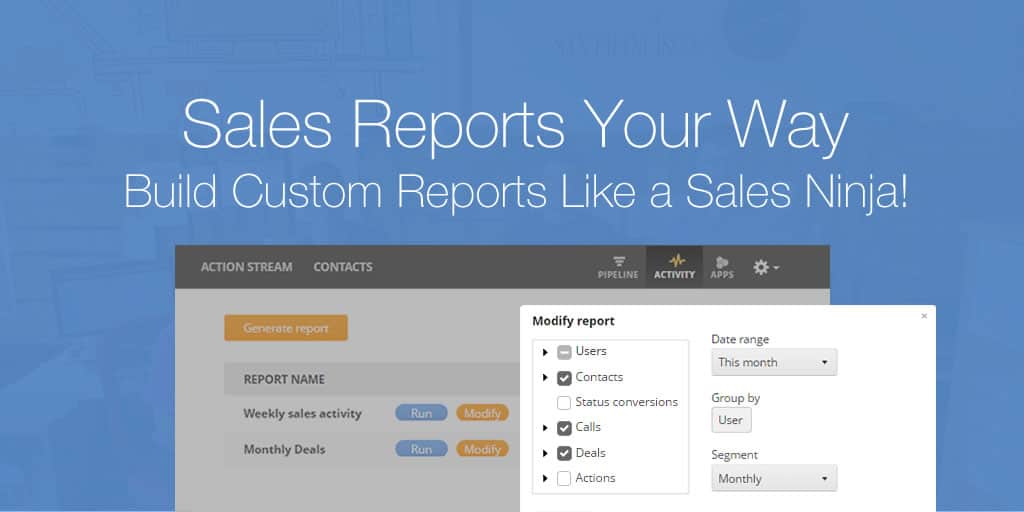
What if I told you that you’ve been organizing leads the wrong way?
It doesn’t matter if you’ve got the fanciest CRM tool or a lead management spreadsheet—if your leads database is just a contact list, and doesn’t push your sales cycles forward, you’re doing your business a disservice.
You need to start organizing leads differently. That means making sure your database not only houses all contacts, but also helps you prioritize them.
In this article, you’ll learn how to organize your leads to help you close more sales.
Why old ways of organizing leads no longer work
The goal of any CRM—whether it’s a software or a spreadsheet—is to help you manage leads. Traditionally, they do this by collecting and arranging your contacts in various ways, the most prevalent being:
- In alphabetical order. The oldest trick in the book, this lists contacts according to their initials. A comes before B, and B before C, and so on. It’s like how you’d log phone numbers in a phone book.
- By sales stage. Many CRMs group leads according to where they are in your sales pipeline.
- By tags. Keywords or labels are assigned to leads. Then, the leads are sorted according to their corresponding keywords (or labels). For example, you can group the most valuable contacts under “VIP”.
- By lead source. Contacts are also sorted based on which lead generation channel they came from.
- And similar sorting parameters.
These methods categorize your contacts according to shared attributes.
Organizing leads is a more advanced step. It’s about creating a sales flow that pushes you (or your team) towards performing sales activities. Not just logging and grouping new contacts.
There’s no point in collecting thousands of leads and then leaving them in your database to collect dust. The longer you keep these contacts idle, the harder it becomes to reach out to them, and the more likely you are to lose sales opportunities.
The best way to organize leads
Have you ever turned a lead into a customer by simply jotting down their data? Probably not.
You still need to carry out a slew of sales activities to get that conversion.
That’s why the best way to organize leads is by sales actions, specifically, by the date of your next interaction with each lead.
In this case, every contact is assigned a next step, and your list is automatically arranged by the urgency of these steps.
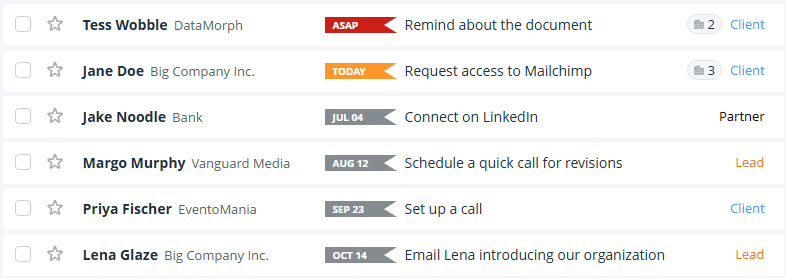
I’ll show you exactly how to do this using a simple but effective Next Action sales method.
1. Prioritize leads in an Action Stream
The more sales actions you complete, the more deals you close.
That’s why I recommend organizing your leads in an Action Stream.
The Action Stream has three important components:
- A list of leads with tasks,
- Due dates for each task,
- Color codes.
First, you need to add a task (a Next Action) to every lead in your database.
If you want to organize your leads in a dynamic “stream”, all Next Actions should also have due dates. In this case, you can sort leads according to how urgently you need to interact with them.
And let’s not forget color-coding. This is the third component of an Action Stream. Color codes are a simple way to sort and prioritize leads and see at a glance:
- When the deadline for a task has passed.
- If the deadline is today.
- When the due date is still far out.
When it’s all said and done, you’ll have a lead management system that not only stores leads but also keeps their sales journeys in flux—always moving forward, like water flowing in a stream.
It’s worth noting that the Action Stream organizes leads automatically.
Let’s say you add Connor Brown to your database and reach out to him the next day via a call.
On the call, he mentions he’ll be ready to consider your offer in 3 months. You can schedule the next outreach in your sales CRM, forget about it, and in the meantime, focus on advancing more pressing sales opportunities.
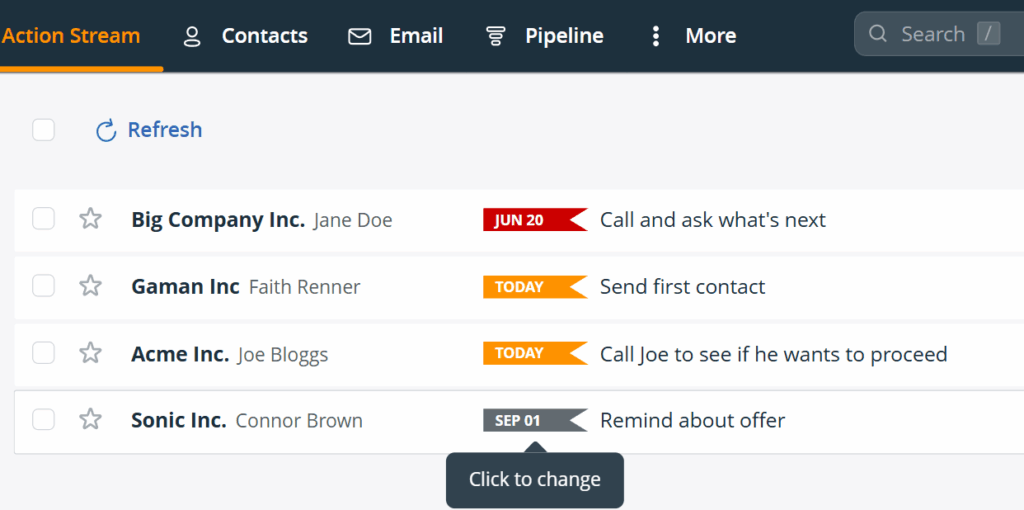
3 months later, Connor will automatically be sorted at the top of your Action Stream with the orange “Today” label:

And if you miss the deadline, the task becomes overdue and turns red—all on its own.
2. Focus on the most urgent tasks
Beyond building a lead management system that nudges you to take actions and move sales opportunities forward, organizing leads is also about doing the right thing at the right time.
Not every sales task is important at the moment. Some can be rescheduled to a later date, while others don’t even need your attention yet. You want your efforts to go to the most urgent opportunities at the time.
Although using an Action Stream will naturally make it easier to see your most pressing sales tasks, it still typically puts all other Next Actions within view. And that can be distracting.
To organize leads properly, you also need to declutter your workspace and get rid of any distractions.
That’s where a Focus mode comes in.
The Focus mode lets you hide all but the leads that you need to work on for the day. They usually have either overdue actions or actions scheduled for today.
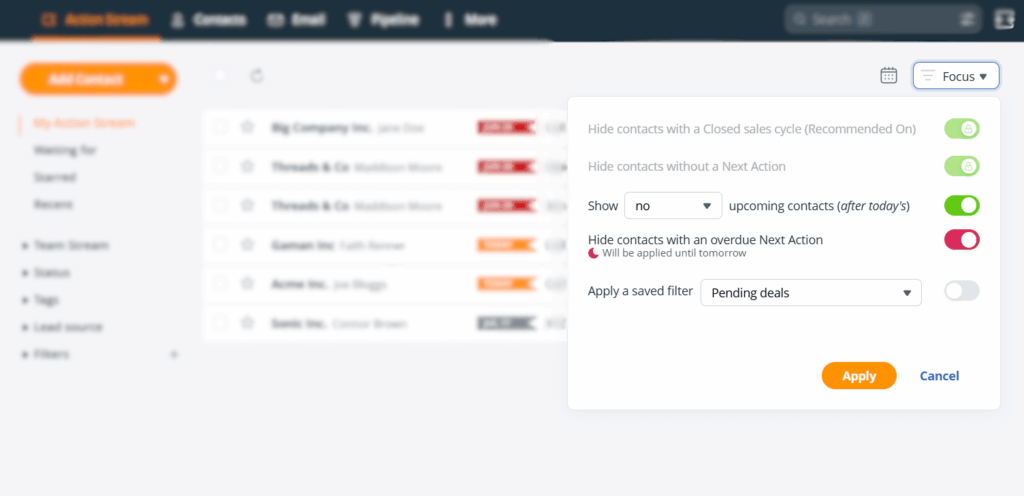
As a result, you won’t be overwhelmed by a long list of leads and will be able to zero in on today’s tasks.
3. Categorize leads into groups
Using an Action Stream to prioritize your leads is great, but your contact list can still become overwhelming.
That’s why you should always categorize your leads.
Categorization means grouping leads based on shared attributes. This might mean segmenting leads by sales stage, lead source, priority level, or the sales rep assigned to them.
With these segments in place, it becomes easier for you to stay organized and carry out targeted sales tasks.
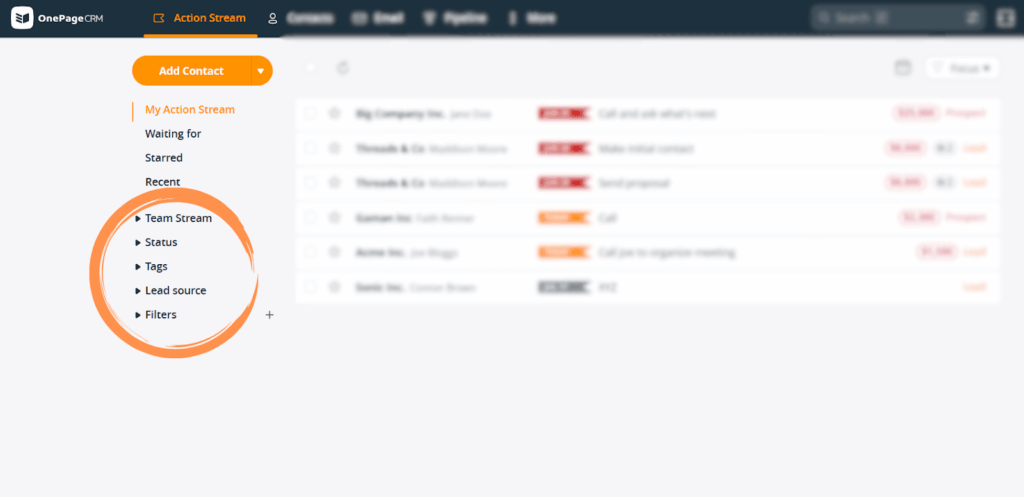
To segment leads:
- Begin by identifying similar attributes, narrowing them down, and using them to create tags.
- Afterward, add the tags to each lead’s record.
- Filter your contact list by any tag, and you’re only going to see leads associated with it.
For example, if you’d like to categorize leads by “Source”, note down the specific channels from which your leads come. Create a tag for each channel—whether it’s social media, advertisement, email, tradeshow, etc.—and add it to applicable leads, and then send them targeted email outreach.

Depending on what tool you use for organizing leads, you can also filter them by custom fields. However, tags are usually the easiest and quickest segmentation method.
4. Delegate work to team members
Nurturing prospects until they become customers comes with a host of duties, all of which one salesperson might not be able to handle.
That’s why delegating work to others is a huge part of a proper way to organize your leads.
You can assign leads to different sales reps. This can help you keep responsibilities divided.
Imagine you have a team of three salespeople. You could make one responsible for APAC, the other one for the Americas, and the third one for Europe. Then you can filter your database based on each sales rep and let them focus on their work without distractions.
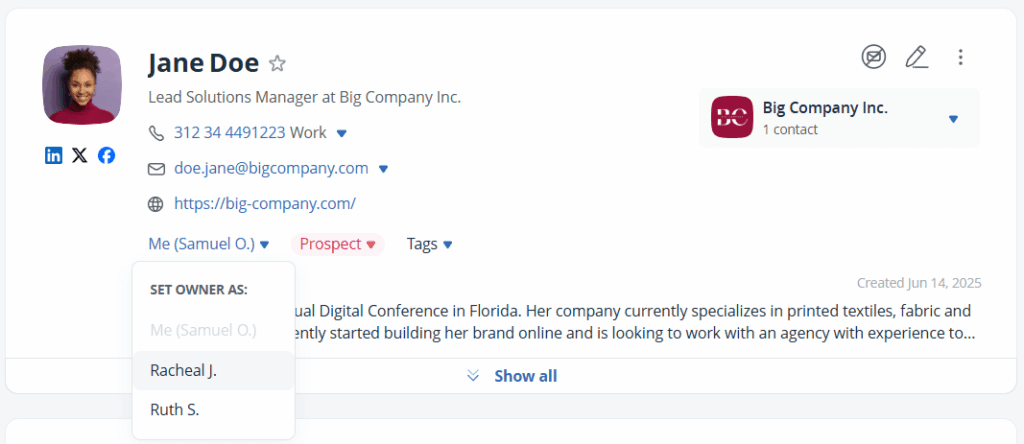
Another form of delegation is assigning Actions to other team members. If you’re managing a lead and reach a point where a particular Next Action is beyond your scope of work, you can simply assign that action (not necessarily the lead itself) to a suitable team member.
For example, you just converted Joe Bloggs into a customer. The next step is onboarding, but since that’s not your job, assign the Action “Start onboarding” to your Customer Success specialist.
In this case, you remain the account manager for Joe Bloggs, but you can delegate tasks that fall outside of your responsibilities to other team members.
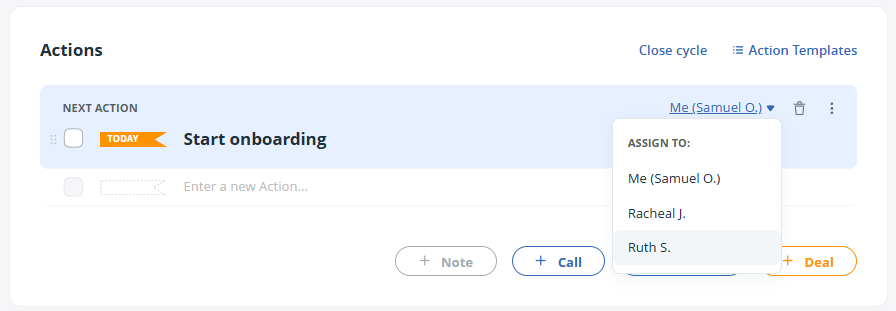
You can also organize leads by delegating sales deals. If you have one lead with two different ongoing deals, you can assign each deal to different team members.
Let’s say a lead bought SEO services and a Leadership coaching session from your marketing agency. You can have one rep work on the SEO deal, while the other handles the Leadership coaching one.
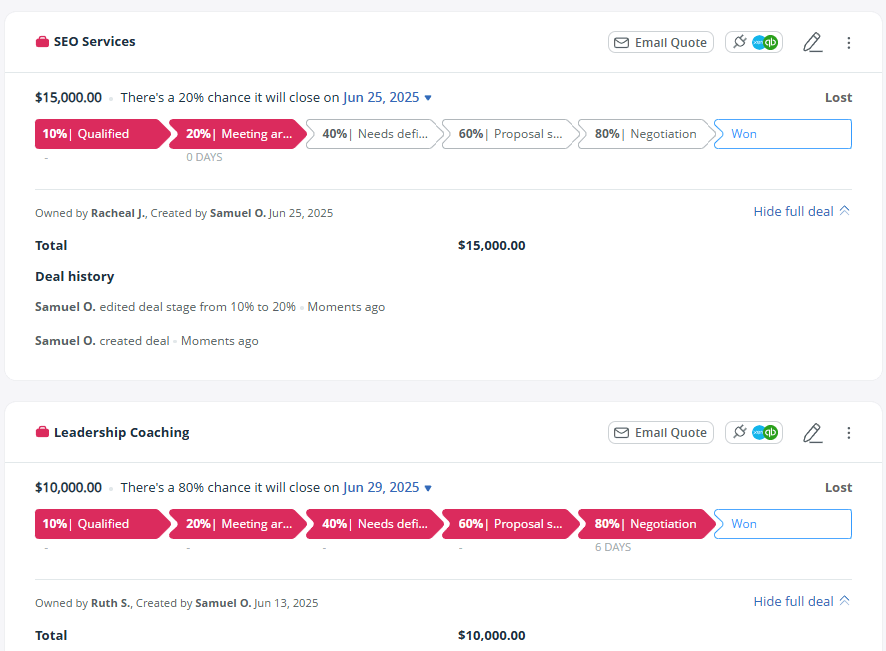
5. Merge duplicated leads
As your database grows, you may start seeing duplicate records. This can happen if, for instance, a lead fills out your web form more than once, or if different sales reps add the same contact by mistake.
If left unattended, these duplicates will clutter your database, waste your team’s time, and even create a poor experience for your leads.
Let’s say Maddison Moore was added to your database twice:
- One sales rep has already made initial contact and is looking to send a proposal.
- But another rep, unaware of this, calls Maddy for another initial conversation.

Besides frustrating Maddy and wasting valuable time, this can make your business look disorganized and unprofessional.
But when you regularly look for and merge duplicates, your database stays clean, everyone has the latest info, and the members of your team can carry out tasks without clashing with each other.
Begin by identifying the duplicates. This typically involves scanning through your contact list to spot leads with the same first and last name.
However, if you have a larger database (and if your lead management software allows), you can simply filter your list by “Duplicates”:
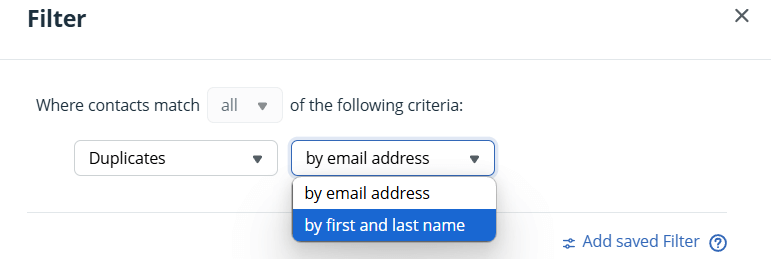
Once you find the duplicates, you can then merge them into one record:
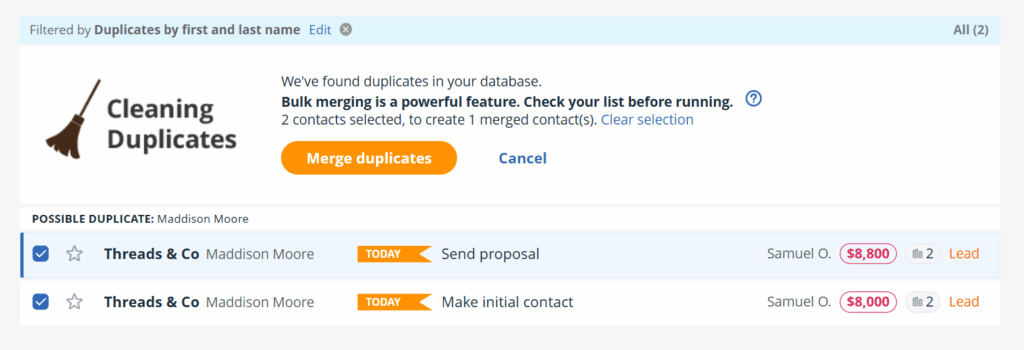
The newly merged contact will display the most recent Next Action you added, alongside the most up-to-date and relevant information.
6. Centralize all lead data
If you’re running a business in the 21st century, chances are you have a tech stack. That is, a collection of software for managing everything, from phone calls and documents to invoices, marketing campaigns, calendar invites, and more.
Your tech stack holds all the information about your leads, but that info is scattered across multiple tools.
As a result, when you’re working on a lead, it’s harder and more time-consuming to gather all of its dispersed data, piece it together, and get the full picture you need to advance that sale.
So, when you’re organizing leads, don’t forget to make all of their data (across various business apps) accessible from your sales CRM.
You can do this by integrating your CRM with other business apps. Suppose you need to send an invoice to a lead. Instead of asking your finance department or opening PayPal in a new tab, you simply connect QuickBooks. It’ll help you build and send the invoice right from your CRM.

Another method is to add widgets of other business apps to your CRM. Rather than wasting time collating data scattered across various platforms, widgets automatically bring everything to your leads database.
For example, you could add a Mailchimp widget to see whether you’ve sent any marketing campaigns to a lead, or attach a widget for QuickBooks or Xero to view past invoices—all from within your CRM.
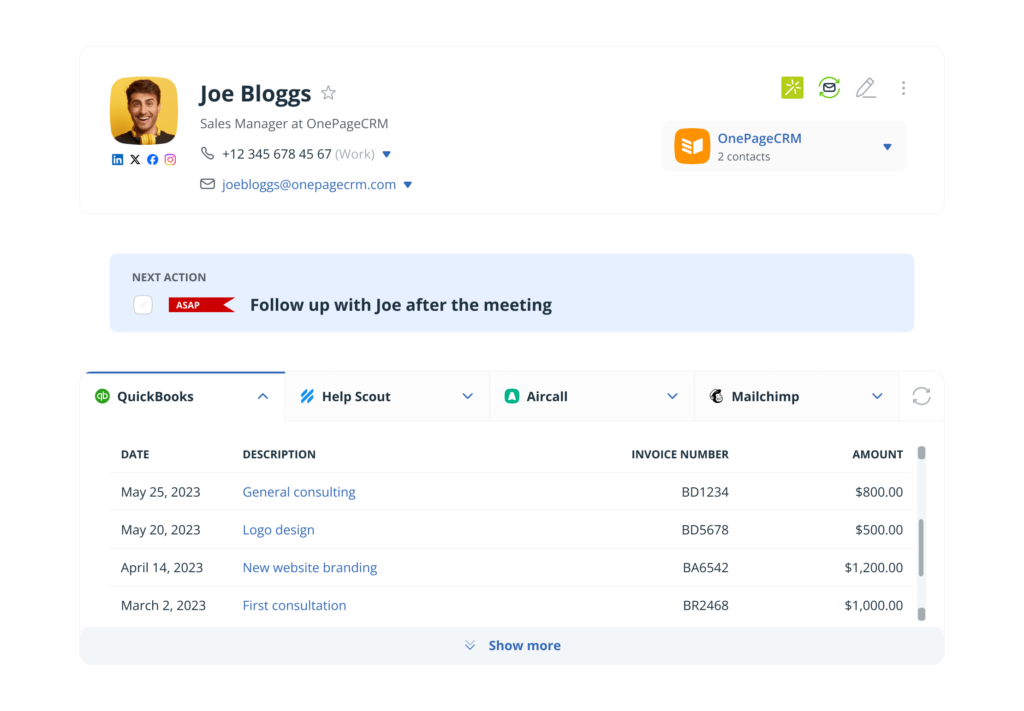
CRM Widgets show you everything at a glance, so you’re not stuck trying to pinpoint the data you need to move leads to the next stage of the sales cycle.
7. Track sales progress
The main reason for organizing leads is to build a system that actively pushes you towards converting leads into sales. And nothing gives you that push quite like seeing your progress in real time.
Tracking your sales progress lets you visualize your sales goals, see how close you are to reaching them, and spot where you need to put in more effort.
There are several ways to track your sales progress.
For starters, I recommend adding a dynamic dashboard to your CRM.
Creating an Activity Log is another route. This gives you live updates whenever you or other members of your sales team interact with any lead.
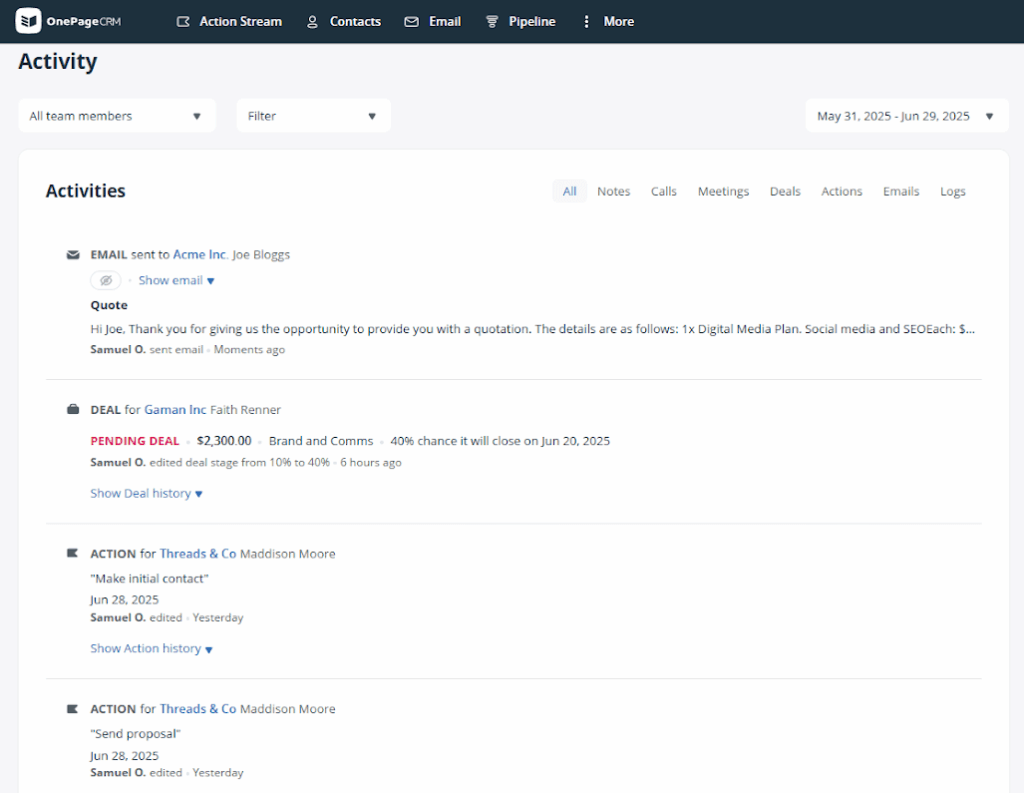
If your CRM supports it, set up custom reports to monitor KPIs that matter to you. And if possible, automate these reports, so they’re delivered to you (and or your team) regularly.
You can also opt for Target Widgets built for tracking sales progress. For example, you add the widget and set a goal to close $5,000 in revenue every month.
The Targets Widget will lurk in your Action Stream, showing you how much revenue you’ve brought in and how close you are to your target.

Benefits of organizing leads in sales
When you organize your leads properly, your database becomes more efficient. Leads are faster and easier to manage, you spend less time on repetitive work, and you start closing more sales, in less time.
But that’s just putting it simply.
Here are a few more things you stand to gain by organizing your leads the right way. The Next Action way.
Keep the sales reps aligned
A well-organized lead database helps your team avoid confusion and steer clear of clashing duties.
When each sales rep is assigned a specific lead or sales task, it becomes less likely for work and effort to be duplicated.
The same applies when you put specific reps in charge of certain deals.
With a properly organized database, everyone always knows who’s responsible for each sales task, lead, or deal. This way, your whole team is on the same page.

Centralize all sales communication
If your leads are organized right, you’ll be able to access all sales communications right from inside your lead management tool.
When you view each lead’s information in your CRM, you’ll be able to see the emails you (and or your team) have sent to and received from them. No personal communication will get into this inbox, keeping you laser-focused on sales.
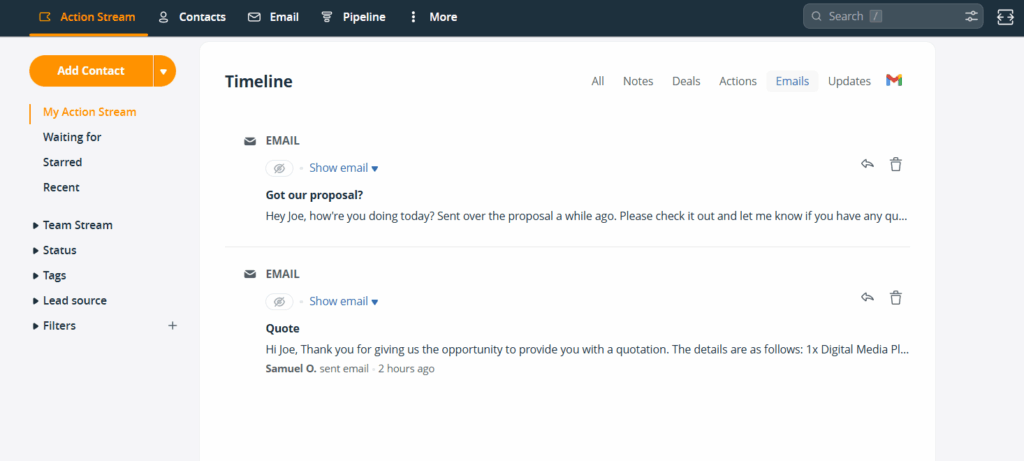
This lets you focus on communicating with the lead without having to sift through thousands of unrelated messages.
Prioritize sales outreach
With an organized lead database, you can focus each outreach effort on where it’ll have the most impact (in terms of response rates and conversions).
By organizing contacts into segments, it’s easy to target the right leads with the right sales message.
For example, let’s say you’re running a 20% promo exclusively for leads that entered your sales funnel through social media. You can filter your list to display only “social media” leads.
Then, send emails to them, explaining how the promo works.
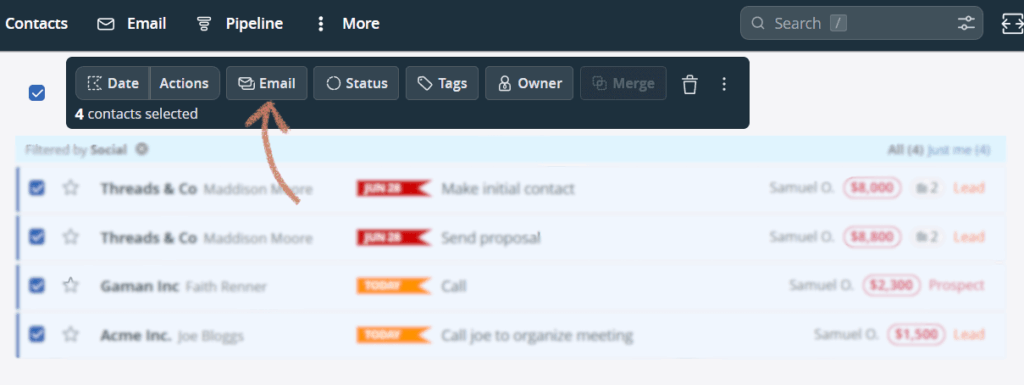
And just like that, a well-organized database ensures your sales outreach is always relevant.
Automate repetitive tasks
When powered by a proper CRM, a well-organized lead database lets you automate sales tasks. This usually involves setting up actions to run automatically when specific triggers occur.
For instance, in OnePageCRM, you can create an automation that sends an email to a contact and updates their status.

By automating your sales workflow, you can cut down on repetitive admin work and make sure your whole team follows the same sales process.
Reduce costs
One of the perks of organizing your leads is that it helps you save money.
When you organize your leads the right way, they’re less likely to drop out of your funnel. So, you won’t need to shell out thousands just to find new ones.
Do you know how much it costs to generate a new lead? Between $91 – $982 per lead! That’s around $1,000 – $10,000 for every ten leads you bring in.
On the other hand, by investing as little as $10 (per user/month), you can create a database that helps you continuously nurture leads.
Scale your business
Expanding your business is also much easier when your lead system is properly organized.
When you have an effective system in place, you (or your team) will make fewer errors and waste less time. There’ll also be more consistency in the way you handle your sales process.
Onboarding new sales reps to handle your increased inflow of leads is also quick and easy. That’s because everything the new reps need to get up to speed—past data about leads and the sales process—is recorded in one place.
All of this means you can generate more leads than you used to, hire more sales reps, take on more work, and in the end, improve your bottom line.
Organize leads and manage sales with OnePageCRM
In any database worth its salt, all the features I’ve mentioned — from the Action Stream to sales progress tracking — must work together to help you move leads through your pipeline.
That’s why OnePagCRM is the best lead management software out there. It has all of the features listed in this article and helps you organize leads, take action, and push sales leads forward.
As the only CRM system with an Action Stream, OnePageCRM has a clean interface and is super easy to use; you can set it up in less than 5 minutes. It’s also more affordable than most other CRM tools, and offers a 21-day free trial (no credit card info required).
No wonder it’s the go-to lead management software for small businesses across 80+ countries. See their reviews here.

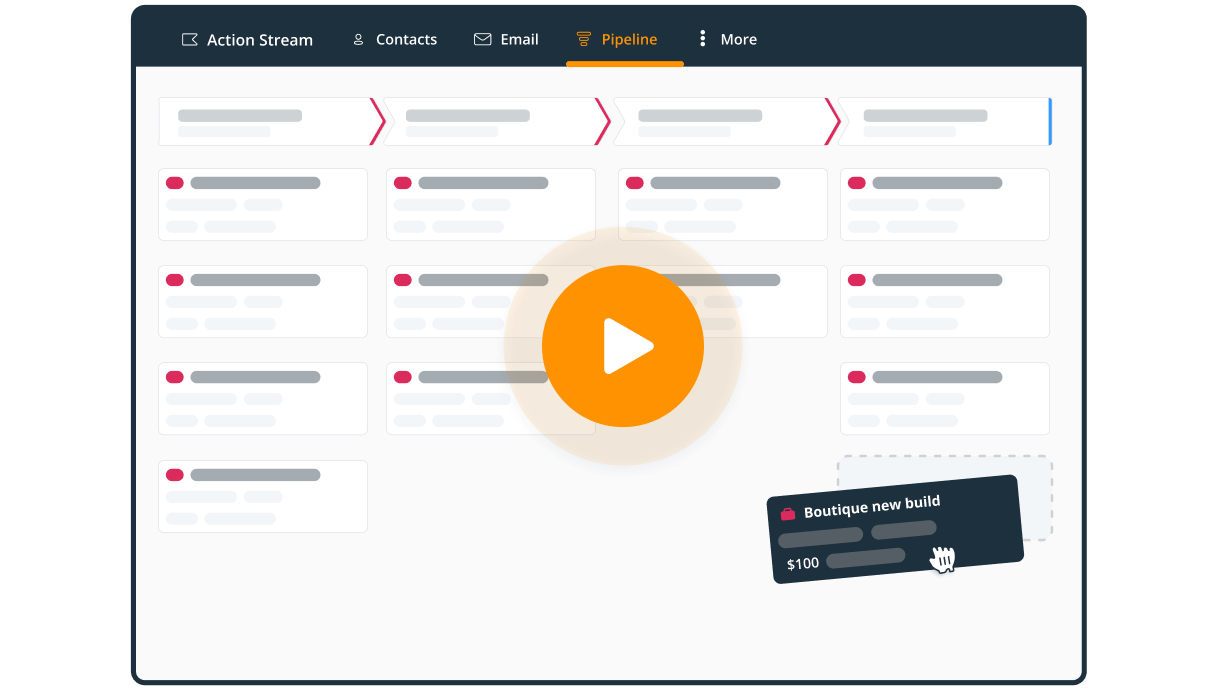




![CRM Dashboard: What is it? [Examples, Benefits, Report Types]](https://www.onepagecrm.com/wp-content/uploads/blog-crm-dashboard-header-v2.png)
